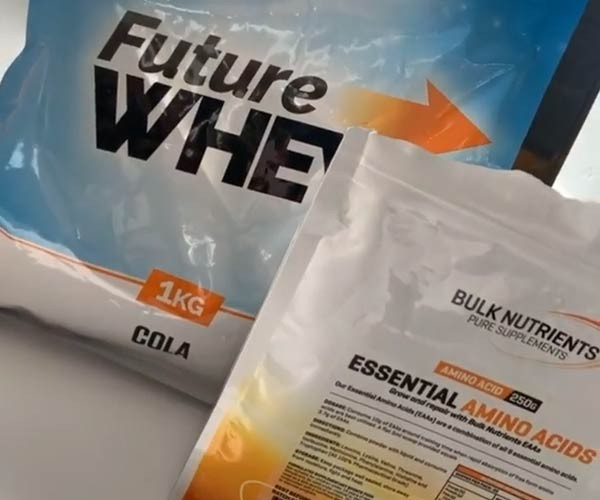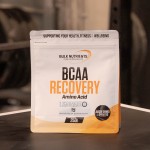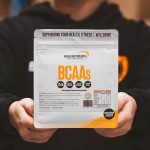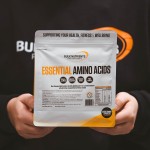BCAAs vs EAAs. Which Comes Out on Top?

What exactly are amino acids?
There is a total of twenty different amino acids that exist. In fact, all twenty of these amino acids are found in a muscle protein this is why they’re commonly referred to as the building blocks of protein.
Nine of these twenty amino acids are referred to as ‘essential’, meaning they are not produced or naturally occur in the body, and therefore must be consumed via your diet or by supplemental means. From the eleven remaining amino acids, these are referred to as ‘non-essential’ because they are produced naturally in the body in adequate amounts.

All you need to know about BCAAs (Branched-chain Amino Acids)
There are three branched-chain amino acids, L-Leucine, isoleucine, and valine. The three branched-chain amino acids also make up one-third of the nine essential amino acids which must be consumed in our diet or via supplements.
There was a lot of interest generated around branched-chain amino acids after early research showed that these three amino acids have a unique ability to stimulate muscle protein synthesis, the process required for muscle growth and repair. L-Leucine specifically, is a direct precursor to muscle protein synthesis (think of it as an on switch) and regulates several anabolic signalling pathways that are involved with protein synthesis.
It’s important to note, however, that the predominance of research demonstrating a positive link between branched-chain amino acid intake and muscle protein synthesis has been conducted in rodents (limited application to human protein synthesis responses), and that although muscle protein synthesis may rise quite rapidly the following consumption in rodents, the effect is relatively short-lived.

So what about EAAs (Essential Amino Acids)?
Just like branched-chain amino acids, essential amino acids muscle be obtained through the diet. Essential amino acids can be thought of as the building blocks of protein that support our muscle and connective tissues in the body. The nine essential amino acids (which include the branched-chains L-Leucine, isoleucine, and valine) are histidine, lysine, tryptophan, phenylalanine, threonine, and methionine. The best sources of essential amino acids include animal proteins like eggs, chicken, and steak.
Since the explosion of rodent research circa 2006 which had everyone grasping for their nearest tub of branched-chain amino acids at the local supplement store, more recent research actually suggests that consuming the full complement of the nine essential amino acids is more beneficial for supporting muscle protein synthesis as opposed to consuming the three branched-chains in isolation. Thinking intuitively this makes a lot of sense, as to achieve the outcome of building a new muscle protein it seems likely that all amino acids would need to be present, not just a select few acting independently (remember a new muscle protein needs to contain all the essential amino acids).
Essential amino acids have also been shown in the research to reduce muscle wastage/loss, enhance muscle growth and support metabolic rate. Studies also suggest that consuming essential amino acids close to your workout can expedite the muscle recovery process.

BCAAs and EAAs both have supporting research behind them, which do I go with?
In most situations, I recommend choosing a full-spectrum essential amino acid product over branched-chain amino acids. Firstly, while branched-chain amino acids might enhance muscle protein synthesis, the effect tends to be quite transient as eventually the muscle building/regenerative processes become limited by lack of one or more of the essential amino acids required to build a new muscle protein. Secondly, an essential amino acid supplement still contains the branched chains! So, don’t think you are missing out on the potential anabolic effects of L-Leucine, isoleucine, and valine, they are still present in your essential amino acids.
Considering that essential amino acids are mostly obtainable for the same price as branched-chain amino acids and with a more comprehensive CV behind them, this makes essential amino acids a standout choice in my eyes for trainers looking to boost their muscle adaptations from training.
A helpful analogy
One analogy I like to use to help people understand why EAAs might be preferable over BCAAs requires us to think about amino acids like bricks in a house. To build a fully functional house with no holes in the walls, we need ALL of the bricks (essential amino acids). Sure, consuming BCAAs might bring more builders to the worksite, but it doesn’t matter how many builders we have if we don’t have all the bricks, the house still won’t get built.

Are there any times BCAAs might be useful?
Yes. For vegan trainers, supplementing with BCAAs can be a great idea. As a vegan consumes plant-protein sources only which are notoriously low in BCAAs (including L-Leucine), they are often missing out on the anabolic actions of these amino acids. Supplementing with BCAAs can give a vegan trainer reassurance that they aren’t missing out on any of the important essential amino acids that are required to maximise muscle growth and repair.
A second use, which I have seen used fairly often, is consuming BCAAs as a hunger or craving aid. Often during fat loss periods when hunger, cravings and taste sensations are heightened, sipping on a fruity tasting BCAA product can sometimes provide some satisfaction in this respect. If the cravings are really becoming a challenge, drinking BCAAs to satisfy sweetness craving urges (while not calorie-free) is a preferable alternative to blowing out on a Slurpee or SupaShake!

BCAAs vs EAAs: A summary
Consuming branched-chain amino acids on top of a diet rich in essential amino acids will add little benefit. However, if you are consuming a variety of plant-based protein sources regularly (which are low in BCAA content), then supplementing can be a wise choice to avoid any deficiencies. EAAs function as an effective complete protein substitute, which can comprehensively enhance strength and size gains if the previous intake of protein was suboptimal. For those struggling to reach ~2 g of protein per kg of body weight daily, opting for EAA supplementation can be an easy and cost-effective method to rectify that.
For a delicious and effective EAA supplement, look no further than Bulk Nutrients' Future Whey. For a quality BCAA supplement with plenty of refreshing flavour options, choose Bulk Nutrients' BCAA Recovery.
Safe supping!

Jackson Peos has completed a PhD at the University of Western Australia, and has a straightforward approach to nutrition and supplements.
He's completed his BSc in Sports Science, and Exercise & Health, and his BSc (Hons) in Exercise Physiology.
More about Jackson PeosReferences:
- Hulmi JJ, Lockwood CM, Stout JR. Effect of protein/essential amino acids and resistance training on skeletal muscle hypertrophy: A case for whey protein. Nutr Metab (Lond). 2010;7:51. Published 2010 Jun 17. doi:10.1186/1743-7075-7-51
- Park, S., Church, D.D., Azhar, G. et al. Anabolic response to essential amino acid plus whey protein composition is greater than whey protein alone in young healthy adults. J Int Soc Sports Nutr 17, 9 (2020). https://www.tandfonline.com/doi/full/10.1186/s12970-020-0340-5
- Wolfe, R.R. Branched-chain amino acids and muscle protein synthesis in humans: myth or reality?. J Int Soc Sports Nutr 14, 30 (2017). https://www.tandfonline.com/doi/full/10.1186/s12970-017-0184-9
Related Blogs

The Ultimate Guide to Amino Acids
Posted by Nick Telesca
Estimated reading time: 33 minutes































